Under irrigation a good commercial grain yield is 6 to 9 ton/ha (10 to 13 percent moisture). The water utilization efficiency for harvested yield (Ey) for grain varies then between 0.8 and 1.6 kg/m3.
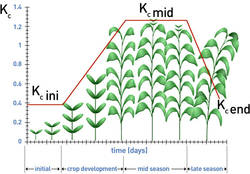
Tobacco (Nicotiana tabacum) is believed to have originated from South America. Present world production is about 6.3 million tons of leaves from 4.2 million ha. (FAOSTAT, 2001).
The crop can be broadly divided according to the method of curing the leaves flue, fire, air or sun-cured. In general, the dark-coloured air and fire-cured tobacco is used for pipe and cigar tobacco, whereas the light-coloured flue and sun-cured is used for cigarette tobacco.
Tobacco is grown under a wide range of climates but requires a frost-free period of 90 to 120 days from transplanting to last harvest of leaves. Optimum mean daily temperature for growth is between 20 and 30°C. A dry period is required for ripening and harvest of the leaves. Excess rainfall results in thin, lightweight leaves. Sun-cured or oriental tobacco requires a relatively dry climate to develop its full aroma. Except for some short-day varieties, cultivated tobacco is day-neutral in its response to flowering.
A light, sandy soil is required for flue-cured, light tobacco. Air-cured, dark tobacco is grown on silty loam to clay loam soils, while fire-cured and air-cured, light tobacco is mostly grown on medium textured soils. The crop is sensitive to waterlogging and demands well-aerated and drained soils. The optimum pH ranges from 5 to 6.5. Quality of the leaves is affected by soil salinity. Depending on the type of tobacco, fertilizer requirements vary and in general are 40 to 80 kg/ha N, 30 to 90 kg/ha P and 50 to 110 kg/ha K.
Tobacco is sown on seed beds and is transplanted 40 to 60 days after sowing when the plants are about 15cm tall. During the first weeks the seedbeds are often covered to protect the young seedlings against unfavourable weather. Spacing after transplantation caries with variety and is generally between 1.2 to 0.9 x 0.9 to 0.6 m. Crop rotation after one or two seasons is recommended with crops such as grass, sorghum, millet and maize that are not susceptible to root eelworm.
To produce high value leaves, topping (removal of flower buds) and desuckering (removal of side shoots) is often practised. Time and height of topping depends on the type of tobacco but is usúal1y done when 10 percent of the plants have their buds in flower.
Stages of Development | Plant date | Region | |||||
|---|---|---|---|---|---|---|---|
Crop characteristic | Initial | Crop Development | Mid-season | Late | Total | ||
Stage length, days | 20 | 30 | 30 | 30 | 110 | ||
Depletion Coefficient, p | 0.4 | >> | 0.5 | 0.65 | – | ||
Root Depth, m | 0.25 | >> | >> | 0.8 | – | ||
Crop Coefficient, Kc | 0.5 | >> | 1.1 | 0.8 | – | ||
Yield Response Factor, Ky | 0.2 | 1.0 | 0.5 | 0.5 | 0.9 | ||
The water requirements (ETm) for maximum yield vary with climate and length of growing period from 400 to 600mm. During the first weeks after emergence in the seedbed the seedlings require 3 to 5 litres/m2 daily. After 30 to 40 days the seedlings receive less water so as to obtain a more robust plant. After 40 to 60 days, the seedlings are transplanted and the crop is harvested 90 to 120 days after transplanting. The period of maximum water requirements occurs 50 to 70 days after transplanting and is followed by a decrease in water requirements.
The crop coefficient (kc) relating crop water requirements (ETm) to reference evapotranspiration (ETo) for the different development stages after transplanting are: during the initial stage 0.3-0.4 (10 days), the development stage 0.7-0.8 (20 to 30 days), the mid-season stage 1.0-1.2 (30 to 35 days), during the late-season stage 0.9-1.0 (30 to 40 days) and at harvest 0. 75-0.85.
Following figure shows growth period in tobacco (Lucas)
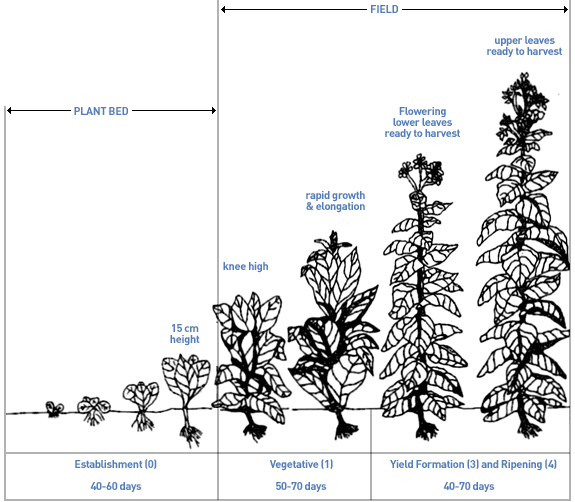
The relationships between relative yield decrease (1 – Ya/Ym) and relative evapotranspiration deficit for the total growing period are shown in the figure below
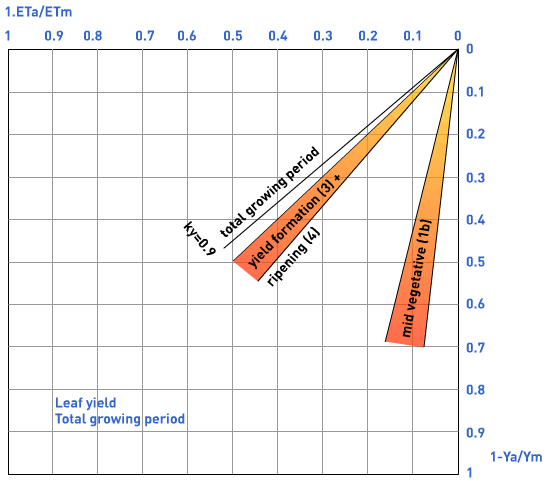
This figure shows the relationships between relative yield decrease (1 – Ya/Ym) and relative evapotranspiration deficit for the individual growth periods.
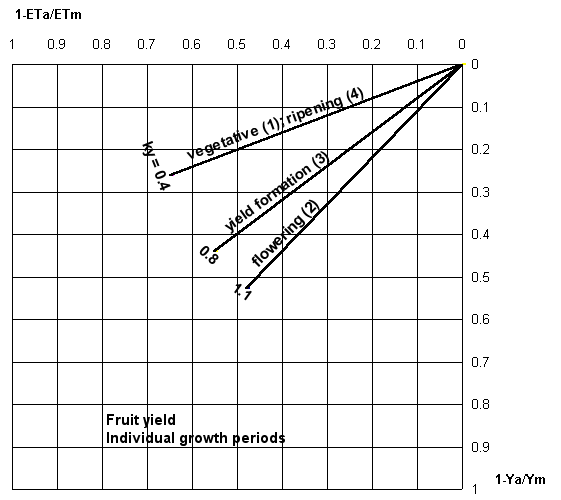
The water regimes from which a full crop of tobacco can be obtained vary from stored soil water, rainfall, supplemental irrigation or full irrigation. Careful water scheduling is required because too frequent irrigation damages the crop. Water deficits in certain periods may increase yields and it is recommended practice to subject seedlings during the establishment period (0) prior to transplanting to a period of moderate water deficit to increase their drought resistance. Also, moderate water deficits during the early vegetative period (1a) may enhance root development. Moderate water deficits during the first 20 to 30 days after transplanting have little effect on final yield but cause temporary retarded growth; however, the crop recovers rapidly with subsequent irrigations. In most cases, final yields may be larger compared to a crop receiving full irrigation throughout this growth period (1a).
Water deficits during the mid-vegetative period (rapid growth, 1b) result in reduced growth and smaller leaves. Severe water deficits during the yield formation and ripening periods (3 and 4) affect leaf weight and chemical composition which in turn affects the fire-holding capacity. However, a mild water deficit during ripening (4) is desirable to restrict growth of new young leaves.
Excess water results in leaves of low quality. Heavy rain or irrigation may cause ‘wilting’, ‘wet feet’ or ‘drowning’. Waterlogging for two or more days generally severely damages the crop and may kill the plants.
To obtain maximum total production under limited water supply, management should be directed towards increasing the area and partially meeting the crop water requirements rather than meeting full crop water requirements over a limited area.
This schematic graph shows the growth periods of maize.
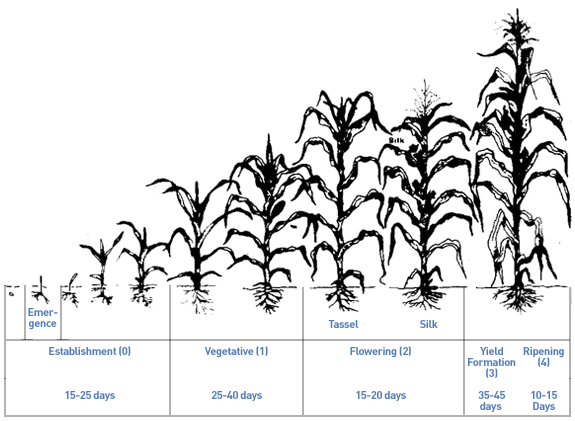
The relationships between relative yield decrease (1 – Ya/Ym) and relative evapotranspiration deficit for the total growing period are shown in the figure below.
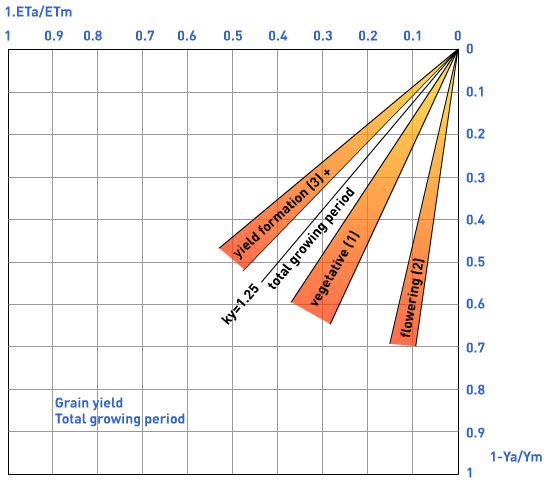
This figure shows the relationships between relative yield decrease (1 – Ya/Ym) and relative evapotranspiration deficit for the individual growth periods.
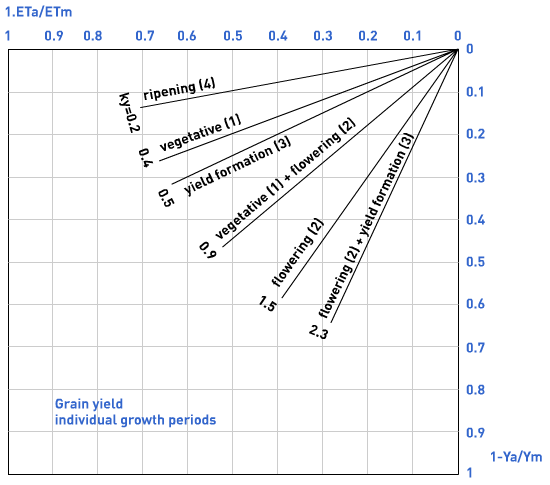
Frequency and depth of irrigation and rain has a pronounced effect on grain yield. Maize appears relatively tolerant to water deficits during the vegetative (1) and ripening (4) periods. Greatest decrease in grain yields is caused by water deficits during the flowering period (2) including tasselling and silking and pollination, due mainly to a reduction in grain number per cob. This effect is less pronounced when in the preceding vegetative period (1) the plant has suffered water deficits. Severe water deficits during the flowering period (2), particularly at the time of silking and pollination, may result in little or no grain yield due to silk drying. Water deficits during the yield formation period (3) may lead to reduced yield due to a reduction in grain size. Water deficit during the ripening period (4) has little effect on grain yield.
The effect of limited water on maize grain yield is considerable and careful control of frequency and depth of irrigation is required to optimize yields under conditions of water shortage. Where water supply is limited it may therefore be advantageous to meet, as far as possible, full water requirements (ETm) so as to achieve near maximum yield from a limited acreage rather than to spread the limited water over a larger acreage.
Maize flourishes on well-drained soils and waterlogging should be avoided, particularly during the flowering (2) and yield formation (3) periods. Waterlogging during flowering (2) can reduce grain yields by 50 percent or more.
When evaporative conditions correspond to ETm of 5 to 6 mm/day, soil water depletion up to about 55 percent of available soil water (Sa) has a small effect on yield (p = 0.55). To enhance rapid and deep root growth a somewhat greater depletion during early growth periods can be advantageous. Depletion of 80 percent or more may be allowed during the ripening period.
Although in deep soils the roots may reach a depth of 2 m, the highly branched system is located in the upper 0.8 to 1 m and about 80 percent of the soil water uptake occurs from this depth. Normally 100 percent of the water is taken up from the first 1 to 1.7 m soil depth (D = 1 to 1.7 m). Depth and rate of root growth is, however, greatly affected by rainfall pattern and irrigation practices adopted. In addition to soil water and nutrient status, root development is strongly influenced by textural and structural stratification, salts and water table.
To obtain a good stand and rapid root development, the root zone should, where feasible, be wetted at or soon after sowing. Taking into account the level of ETm, to meet full water requirements, the water depletion level is about 40 percent in the establishment period (0), between 55 and 65 percent during periods 1, 2 and 3, and up to 80 percent during the ripening period (4).
Where rainfall is low and irrigation water supply is restricted, irrigation scheduling should be based on avoiding water deficits during the flowering period (2) followed by yield formation period (3). When a severe water deficit during the flowering period (2) is unavoidable, water may be saved by reducing supply during the vegetative period (1) as well as during the yield formation period (3) without incurring additional yield losses.
Under conditions of marginal rainfall and limited irrigation water supply, the number of possible irrigation applications may vary between 2 and 5. A suggested timing of these irrigation applications is given below. To obtain a good stand and proper root development, the potential root zone should be wet either from rainfall or irrigation prior or soon after sowing.

Under irrigation a good commercial grain yield is 6 to 9 ton/ha (10 to 13 percent moisture). The water utilization efficiency for harvested yield (Ey) for grain varies then between 0.8 and 1.6 kg/m3.
